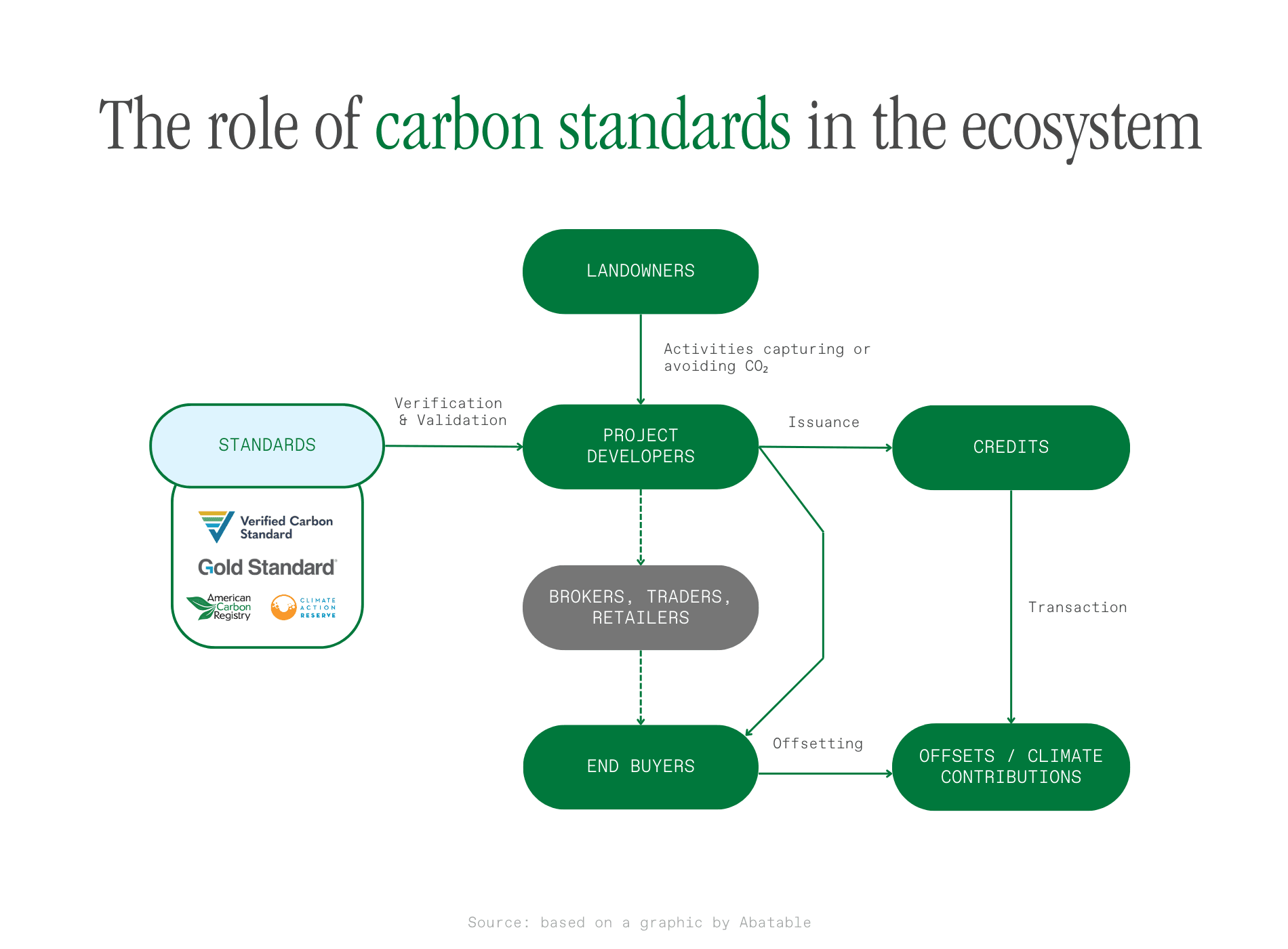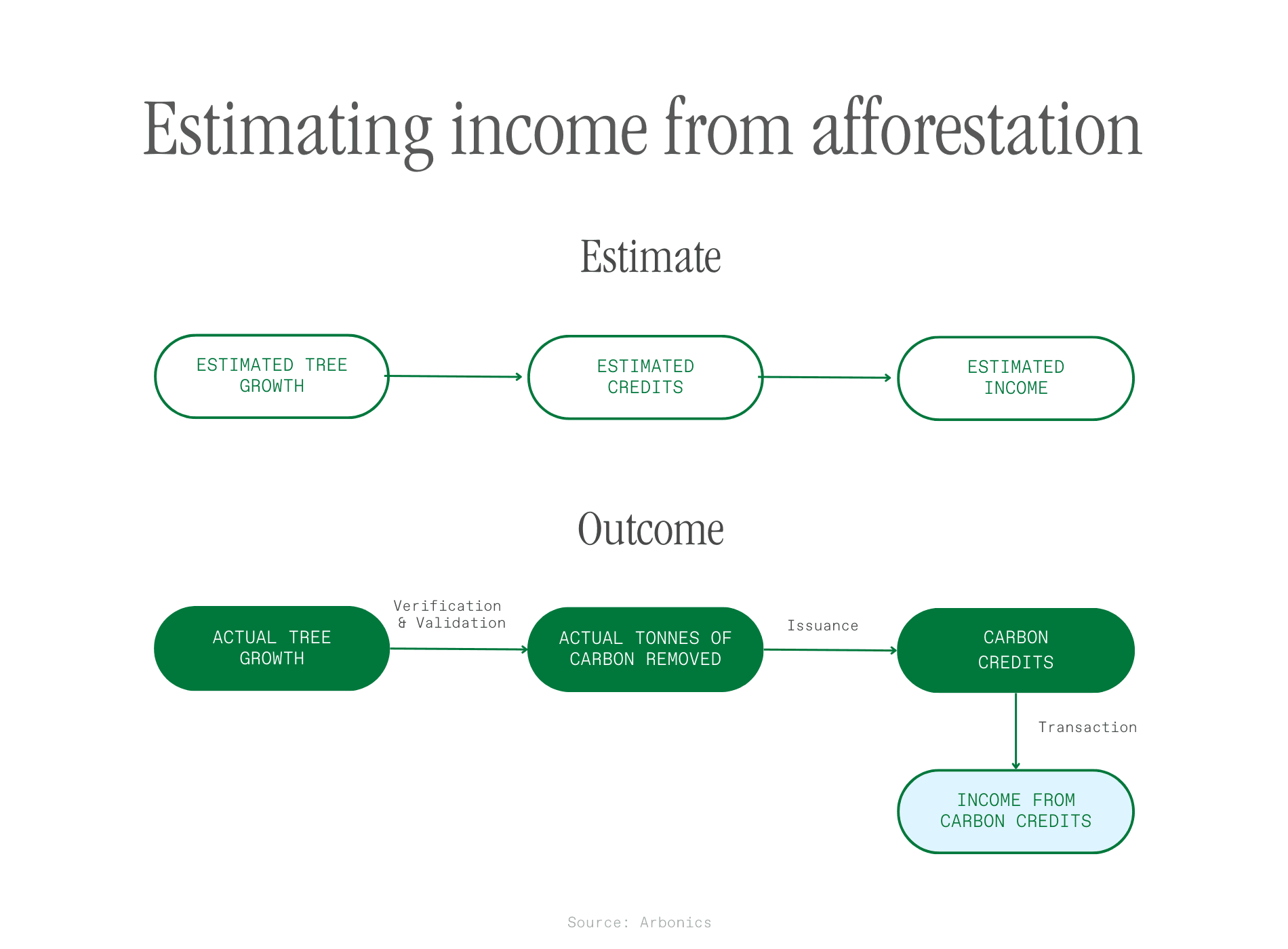6 questions every landowner should ask a carbon project developer
Carbon credits open a window to new revenue sources for forest-and landowners. So how can a landowner choose the right partner when it comes to generating these additional revenues?
The voluntary carbon market is still developing and is growing fast (read more about it here, which means rules and standards are still changing and choosing the right partner can be tricky. But this growth also means that there are more partners to choose from than ever before. These partners, who are opening that window of extra revenue for landowners, are called carbon project developers.
Carbon project developers play a central role in the voluntary carbon market by working with the standards and verification bodies and selling credits, that they worked to create, to the buyers on the market. In order to generate credits, they usually pool together interested landowners to generate cost efficiencies for everybody involved.

Adapted from: Abatable Carbon Developer Ecosystem Report 2021
But the project developers also set the rules for their carbon programmes, which can lead to varying levels of support for landowners and differing entry requirements. So how can you know you’re choosing the right one? A good starting point is to ask the following questions.
How accurate is the estimated benefit for the landowner?
The main promise from project developers to landowners is income from carbon credits. When it comes to forest carbon projects, forest growth models can be used to estimate and forecast the amount of carbon trees will sequester when growing, which can then be used to estimate the number of carbon credits generated over the years and income based on that. However, it’s important to note that the credits issued are calculated by measuring the real growth of trees and how much carbon is stored (1 tonne of carbon = 1 carbon credit). Once the measurement has happened, the verification body will issue the credits based on this real benefit that has occurred.
That means two developers can offer a landowner different estimated income from afforestation on the same land plot. The estimated income can vary significantly based on various factors such as the tree species chosen and the forest growth model used. Landowners must also keep in mind that the result will likely be in a range - which means the landowner can be shown an estimated income from either the top, middle or bottom of the range. That in itself can already cause offer results to vary. However, whichever developer the landowner chooses to go with, the number of credits will ultimately be determined based on the real-life growth of the trees and will be issued when measurement and verification take place. In a nutshell, the actions of the landowner, such as how well they tend the young trees, will have an effect on the number of credits received. The initial estimations provided by project developers ultimately have little effect on the final amount of credits and income.

Beware of unrealistic income promises, as sometimes developers may misrepresent the real earning potential, just like car manufacturers over-promise fuel consumption claims. You might read in the brochure that a car can return 4.5 L / 100 km in perfect conditions, but after you buy the car you learn that in real-world driving it only averages 8 L / 100 km. Carbon credit estimations are the same. For example, a project developer can claim that under best conditions a plot of land may generate 300 credits / ha worth of credits over the whole forest rotation cycle, but on average that land will generate 180-200 credits / ha.
That is why it’s important to ask questions to understand how the developer is assessing quality and supporting landowners in ensuring that the real benefit of the project is maximised.
What are their goals?
The demand for carbon credits is growing and so are the prices, which makes generating carbon credits a great business opportunity. And it’s great if one of the goals of the project developer is generating extra income for landowners and themselves in the process.
However, it’s important to remember the main goal of carbon credits and the promise they deliver to buyers. That is avoiding and removing carbon emissions from the atmosphere. Therefore it is important that one of the goals of the developer is to have a real measurable impact with the credits they are generating. In order to have an impact, the project developer needs to focus on the quality of the credits generated.
Higher quality credits also make more business sense as buyers are more likely to purchase these credits and do so at a higher price. This in turn will generate higher returns for both developers and participants.
How are they ensuring the quality of the credits?
It’s crucial that the credits generated are high quality and deliver the impact promised. In order to ensure the quality of the credits, developers need to consider measures such as additionality, permanence, leakage and co-benefits of their projects. These are widely accepted standards of quality within the industry.
It’s important to check that the project developer is aware of this and that they are always considering the quality of their credits throughout the process. In addition to figuring out their goals, how can you check that the project is set up to generate high-quality credits? Let’s ask the next question.
Who are they working with?
In order to prove that real benefits have been created, carbon credits need to be verified. This is where the independent verification bodies come in and you can ask - who is the project developer working with?
The role of policing the standards set for carbon credits falls to verification bodies, such as Verra and Gold Standard. We covered their role in more detail here ABC: who are Verra and Gold Standard and why do they matter?. Increasing interest and investment in the market has increased scrutiny not only on project developers but also on these standard and verification bodies. This means project developers and verifiers must work closely together to ensure projects realise the promised impact. Oversight on standards is also increasing with the number of rating agencies dedicated to assessing the quality and effectiveness of different carbon programmes. And there are even awards for class-leading project developers (see Voluntary Carbon Market Rankings by Environmental Finance Awards).
To see how different carbon projects are rated, you can also check independent rating agencies such as Carbon Plan CDR Database, BeZero Carbon Ratings and Sylvera.
Additionally, since the carbon verifier ultimately decides, how many credits are issued, it is also important that your developer is up to date with the latest standards and working hard to obey all relevant rules. While a shortcut during the project development phase may make your life as a landowner easier, it is likely to reduce your chances of earning credits.
If you believe the project developer is genuine about their goals to make a difference and they are working with trusted standards and verification organisations, you have hopefully found a project developer that can be a good partner for you.
What about fees and costs?
Setting up and managing carbon projects is costly. In order to make the entire project worthwhile, project developers will most likely take a cut from the benefits generated in order to cover these costs. This can take many forms and you should definitely find out how it will affect the income you will receive from joining the project.
Project developers should be upfront with you about the fees they are charging for their services. They can explain how the benefit (either credits or income from credits) is split between you and them. In addition to checking what that fee covers, also check how costs are distributed throughout the process - including planting, monitoring, verification and sales costs. In some cases, a project developer might cover all of these costs and charge a flat fee for all of their services. But in some cases, some costs (such as planting) need to be covered by landowners. Make sure there are no hidden fees and that you are clear about what (if any) costs need to be covered by you.
In addition to covering costs associated with verification and monitoring, the developer might offer other benefits to make you choose them over someone else. It’s good to check what this might include and you can ask…
How will they support me?
The voluntary carbon market is still in its early days, growing and changing fast. In order to keep up to date with the latest developments, project developers need to hire the best talent and experts in the market to help them navigate the changes and keep their projects adhering to the high standard mentioned above. In order to attract you to work with them they might offer to share their expert knowledge with you.
This can take many forms - sharing useful information and news on their channels, connecting you to experts in the field or helping you build relationships with other landowners on the programme. Make sure to check the resources and support they can offer you throughout the process.
Working with project developers often requires you to enter into decades-long agreements. It’s really important to do thorough homework and ask these questions, and more, before signing up for a programme. Ensuring it’s the right fit for you and the developer, so you can create value for yourself, the credit buyers and the planet.


